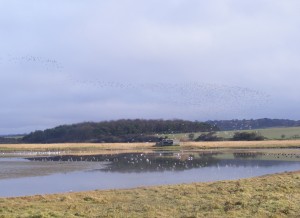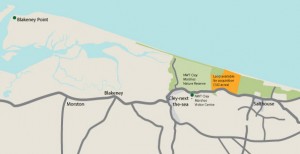I’ll be at the Norfolk Wildlife Trust Cley Visitor Centre tomorrow morning signing copies of my book, Fighting for Birds, for anyone who wants a copy (or copies – remember Christmas isn’t that far away).
I have many happy memories of Cley, but before we get on to them, and how you can help to give future generations happy memories of this fantastic place too, let me just say ‘Thank you!’ to Stephen Moss for his fantastic review of Fighting for Birds in the current issue of Birdwatch.

Now Cley, and its famous East Bank, was one of the places that I really wanted to visit as a kid keen on birds. Eventually I did get there, on a family holiday, and it lived up to expectations and produced my first ever bittern and first ever bearded tit – just the type of birds a West Country boy hoped to see in East Anglia.
I’ve kept going back to Cley over the last 40 years for the birds, for the birders and for the fantastic scenery.
Over the years I’ve seen little auks, Sabine’s gulls, pomarine skuas, grey phalaropes and sooty shearwaters off-shore; great reed warbler, black-winged pratincole, barred warbler, dusky warbler on the reserve or very nearby and hosts of waders from Kentish plover, Temminck’s stint and pectoral sandpipers on the marshes. Throw in the waxwings, ospreys, glaucous gulls, spoonbills etc and it is a place with many great birding memories.
Cley has been the place for many chance-encounters with friends and in the early days of my visits was a place to learn from the great Richard Richardson (who was a kind mentor to young birders) and encounter the rather gruff former-warden Billy Bishop.

But even on a completely birdless day – and there aren’t many of them – Cley is a beautiful place if you can lift your eyes and your heart away from simple bird-spotting. As you look back south across the marshes from the shingle beach it is a glorious view. The flatness of the marshes and reedbeds stretches away to the coast road and behind that in front of you lies the new visitor centre which is actually rather attractive (and if, instead, you are inside the visitor centre you have a wonderful view north to the coast (and just behind you on the shelves are copies of Fighting for Birds)).
To the right lies the village of Cley, where birders come to die, and where sits the attractive windmill that stars on many postcards. Inside Cley is the George Hotel (I don’t know what it is like now – probably very nice – but it has never had the friendliest reputation in my experience) and the Pinkfoot Gallery on the other side of the road from the Cley delicatessen which will sell you a decent wine and a decent sun-dried tomato to make up your picnic! In the valley of the River Glaven there is Wiveton church near where I saw one of my last UK great grey shrikes quite a few years ago.
Back on the beach though, the church to your right which dominates the skyline is that of Blakeney set on the hill dominating the westward view.
Bring your gaze back across the reeds and marshes in front of you and you may well see a marsh harrier, little egret or avocet in flight. Look further east and you look towards Salthouse where its fine church dominates that part of the view. Behind it is Salthouse Heath where nightjars still churrrrrr in summer alongside the occasional burst of nightingale song.

Between you and Salthouse, and north of the coast road, lies a mixture of reed-fringed fields which I have walked past and driven past often, but never penetrated although all that may change if the Norfolk Wildlife Trust are successful in their appeal to raise £1m.
If NWT can buy this land then they will be able to improve its management for wildlife and the access that birders like you and I have to this beautiful and bird-rich part of the north Norfolk coast.
I wish them every success – why not donate to the appeal and tell the world what Cley means to you.
Maybe I’ll see you on Saturday morning at Cley NWT between 10am and 12 midday, but if not then maybe we’ll catch up at RSPB Titchwell between 1pm and 3pm?
[registration_form]
Cley is definately bliss, I remember my first trip and stepping out of the car and just said “wow”, I didn’t realise I said it out aloud, it was only the smirks of the birders I went that made me realise. I’ve seen so many of my “firsts” there, Wilson Phalarope,Grey Phalarope,Pom Skua,Hen Harrier and even a Chinese Water Deer. After an exhausting day of photographing and walking along the shingle beach I was straight up to visitor centre and became a NWT member and 6 years on, still am. The staff were so helpful, suggesting other locations to visit what to see and where etc so reserves should take a leaf out of their books in friendliness and enthusiam, but please can they serve something other than “veggie” options. I do hope they raise the money to buy the land between Cley and Salthouse, one option would be to put a “bucket” on the visitor centre counter, I for one would be happy to donate.
What do you think of Natural Englands proposal to stop people from using a huge chunk of the North Norfolk coast and stoping all activities from rambling,birding and fishing etc, as Cley Marshes was in that area?
Reading your article made me reminisce on how much Cley means to me. A wonderful unique environment, Cley is one of my most favourite places in the world. I’ve been going down there birding since I was a little girl… I remember Richard Richardson on his huge motor bike on the East bank. I so hope the NWT are successful in their appeal and raise the money to protect the land between Cley and Salthouse for future generations…. I’m back down to look after the Pinkfoot gallery next weekend… Can’t wait!
Sharon – welcome and thank you. cley looked lovely yesterday morning (as did Titchwell yesterday afternoon).